Walking Reykjavik (Part 3) — Green Reykjavik
October 1, 2017 - 2 minutes read
Hljómskálagarður Park. Photo courtesy Visit Iceland.
The Vikings really should have switched the names of the two giant islands they settled in the North Atlantic. Iceland is surprisingly green . . . and Greenland boasts more ice than any other island on the planet.
Before or after your voyage with Iceland ProCruises, discover Iceland’s green side on a walk through Reykjavik’s many parks and gardens, starting from Hljómskálagarður in the city center. With its sweeping lawns and wooded corners, the park spreads along the shore of a freshwater lake with views across the water to the city’s modern city hall and Lutheran Free Church (built in 1903). The park also features the sculptures of five Icelandic female artists.

Kjarvalsstaðir Art Museum
From the big roundabout on the east side of Hljómskálagarður, walk down the broad avenue called Gamla Hringbraut (past the hospital) to Klambratún City Park. One of Reykjavik’s favorite spaces for outdoor recreation and entertainment, this large square green space features a Frisbee golf course, beach volleyball courts and free summer concerts. The park is also home to the Kjarvalsstaðir museum of modern art, which highlights the works of many prominent Icelandic artists. The museum café is a great place to pick up a snack or drink before you continue the walk.
If you’ve got a good city map, follow a zigzag course of several major streets to Laugardalur district, venue for half a dozen different parks, gardens and sports grounds. Foremost among these is the Húsdýragarðurinn, a small family friendly zoo that revolves around Icelandic farm animals and indigenous wildlife like harbor seals, reindeer, mink and foxes.

Grasagarður Reykjavíkur
Adjacent to the zoo, Grasagarður Reykjavíkur (Reykjavik Botanical Garden) offers more than 5,000 species of plants native to northern temperate zones like Iceland, as well as summertime entertainment and Café Flora, where many of the dishes are made with ingredients grown in the surrounding gardens.
0 Comments